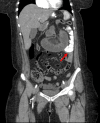Petersen's Hernia After Roux-en-Y Gastric Bypass: A Case Report
- PMID: 38239520
- PMCID: PMC10796129
- DOI: 10.7759/cureus.50757
Petersen's Hernia After Roux-en-Y Gastric Bypass: A Case Report
Abstract
Internal hernia (IH) is the protrusion of abdominal contents, mostly small bowel loops, through a defect in the peritoneum or mesentery. Petersen's hernia is a type of internal hernia, in which part of the intestinal loop protrudes through a defect between small bowel limbs, transverse mesocolon, and retroperitoneum. It has been reported in individuals undergoing gastrojejunostomy (GJ), especially following bariatric surgeries. Because of the expanding popularity of these surgical treatments, the total incidence of internal hernias has recently increased. The laparoscopic Roux-en-Y gastric bypass (RYGB) has been proven to be a safe and successful alternative to the classic open RYGB. Although the absence of postoperative adhesions is one advantage of minimally invasive surgery, it facilitates the occurrence of internal hernia with reported rates of 5% three months to three years following surgery. Clinical findings are vague and can vary from mild to severe abdominal pain that can be accompanied by vomiting, nausea, and abdominal distention.
Keywords: bariatric surgery; bowel obstruction; internal hernia; peterson’s hernia; roux-en-y gastric bypass.
Copyright © 2023, El Nogoomi et al.
Conflict of interest statement
The authors have declared that no competing interests exist.
Figures



References
-
- Review of internal hernias: radiographic and clinical findings. Martin LC, Merkle EM, Thompson WM. https://www.ajronline.org/doi/full/10.2214/AJR.05.0644. AJR Am J Roentgenol. 2006;186:703–717. - PubMed
Publication types
LinkOut - more resources
Full Text Sources
Research Materials
